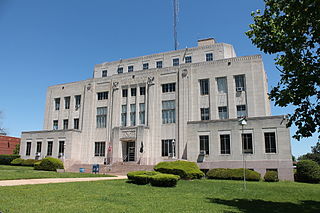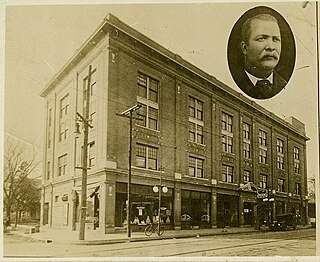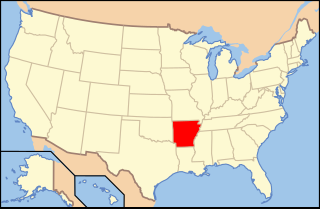
Arkansas is a landlocked state in the South Central region of the Southern United States. It borders Missouri to the north, Tennessee and Mississippi to the east, Louisiana to the south, Texas to the southwest, and Oklahoma to the west. Its name derives from the Osage language, and refers to their relatives, the Quapaw people. The state's diverse geography ranges from the mountainous regions of the Ozark and Ouachita Mountains, which make up the U.S. Interior Highlands, to the densely forested land in the south known as the Arkansas Timberlands, to the eastern lowlands along the Mississippi River and the Arkansas Delta.

Miller County is a county located in the southwestern corner of the U.S. state of Arkansas. As of the 2020 census, the population was 42,600. The county seat is Texarkana.

Ashley County is a rural South Arkansas county with a culture, economy, and history based on timber and agriculture. Created as Arkansas's 52nd county on November 30, 1848, Ashley County has seven incorporated municipalities, including Hamburg, the county seat and Crossett, the most populous city. The county is also the site of numerous unincorporated communities and ghost towns. The county is named for Chester Ashley, a prominent lawyer in the Arkansas Territory and U.S. senator from the state from 1844 to 1848.

Arkansas County is a county located in the U.S. state of Arkansas. As of the 2020 census, the population was 17,149. Located in the Arkansas Delta, the county has two county seats, DeWitt and Stuttgart.

Jacksonville is a city in Pulaski County, Arkansas, United States, and a suburb of Little Rock. As of the 2010 census, the population of the city was 28,364. It is part of the Little Rock–North Little Rock–Conway Metropolitan Statistical Area with 729,135 people as of 2014.

Fayetteville is the second-most populous city in Arkansas, the county seat of Washington County, and the most populous city in Northwest Arkansas. The city is on the outskirts of the Boston Mountains, deep within the Ozarks. Known as Washington until 1829, the city was named after Fayetteville, Tennessee, from which many of the settlers had come. It was incorporated on November 3, 1836, and was rechartered in 1867. Fayetteville is included in the three-county Northwest Arkansas Metropolitan Statistical Area, which is ranked 100th in terms of population in the United States with 576,403 in 2022 according to the United States Census Bureau. The city had a population of 99,285 in 2022.

The Department for Culture, Media and Sport (DCMS) is a ministerial department of the Government of the United Kingdom. It holds the responsibility for culture and sport in England, and some aspects of the media throughout the UK, such as broadcasting. Its main offices are at 100 Parliament Street, occupying part of the building known as Government Offices Great George Street.

Tourism in Sri Lanka faces many challenges, including the ongoing economic and political crisis. In 2018, tourist arrivals peaked at 2.5 million, who spent a total of US$ 5.6 billion in the country. However, the COVID-19 pandemic caused tourist numbers to decrease by 92% in 2020. As of 2022, tourist numbers have not rebounded from the pre-crisis high. The government is attempting to attract foreign investment in the country's tourism industry, which began in earnest after the end of the Sri Lankan Civil War in 2009.

Central Arkansas, also known as the Little Rock metro, designated by the United States Office of Management and Budget as the Little Rock-North Little Rock-Conway Metropolitan Statistical Area, is the most populous metro area in the U.S. state of Arkansas. With an estimated 2020 population of 748,031, it is the most populated area in Arkansas. Located at the convergence of Arkansas's other geographic regions, the region's central location make Central Arkansas an important population, economic, education, and political center in Arkansas and the South. Little Rock is the state's capital and largest city, and the city is also home to two Fortune 500 companies, Arkansas Children's Hospital, and University of Arkansas for Medical Sciences (UAMS).

The Museum of Discovery, formerly the Arkansas Museum of Natural History and Antiquities, is located in downtown Little Rock, Arkansas. The museum is housed in a historic building in the River Market District on the Arkansas River. The museum has a focus on STEM education, and all of the exhibits are interactive. It features a record-breaking musical bi-polar tesla coil, and also includes a large live animal collection.

The Mosaic Templars Cultural Center is a nationally-accredited, world-class Department of Arkansas Heritage Museum and Cultural Center in Little Rock, Arkansas, United States. Its mission is to collect, preserve, interpret, and celebrate African American history, culture, and community in Arkansas from 1870 to the present and to inform and educate the public about Black achievements, especially in business, politics, and the arts.

The geography of Arkansas varies widely. The state is covered by mountains, river valleys, forests, lakes, and bayous in addition to the cities of Arkansas. Hot Springs National Park features bubbling springs of hot water, formerly sought across the country for their healing properties. Crowley's Ridge is a geological anomaly rising above the surrounding lowlands of the Mississippi embayment.

Milton Pitts Crenchaw was an American aviator who served with the Tuskegee Airmen during World War II and was the first Arkansan to be trained by the federal government as a civilian licensed pilot. He served during World War II as a civilian flight instructor. He was one of the two original supervising squadron members. In 1998 he was inducted into the Arkansas Aviation Hall of Fame. The grandson of a slave, he was known as the "father of black aviation in Arkansas" who broke through color barriers in the military.

Little Rock is a city in and the capital of the U.S. state of Arkansas, of which it is also its most populous. The city's population was 202,591 as of the 2020 census. The six-county Little Rock metropolitan area is the 81st-most populous in the United States with 748,031 residents according to the 2020 census.

The culture of Arkansas is a subculture of the Southern United States that has come from blending heavy amounts of various European settlers culture with the culture of African slaves and Native Americans. Southern culture remains prominent in the rural Arkansas delta and south Arkansas. The Ozark Mountains and the Ouachita Mountains retain their historical mount. Arkansans share a history with the other southern states that includes the institution of slavery, the American Civil War, Reconstruction, Jim Crow laws and segregation, the Great Depression, and the Civil Rights Movement.

The Museum of Black Arkansans and Performing Arts Center is a museum and performing arts venue at 1224 South Louisiana Street in Little Rock, Arkansas. It is located on the former campus of the First Baptist Church of Little Rock, an historic property listed on the National Register of Historic Places in 1994. The former church, built in 1941, is a prominent local example of Collegiate Gothic architecture, designed by local architect A.N. McAninch. Little Rock's First Baptist congregation now meets at 62 Pleasant Valley Drive.

Northwest Arkansas (NWA) is a metropolitan area and region in Arkansas within the Ozark Mountains. It includes four of the ten largest cities in the state: Fayetteville, Springdale, Rogers, and Bentonville, the surrounding towns of Benton and Washington counties, and adjacent rural Madison County, Arkansas. The United States Census Bureau-defined Fayetteville–Springdale–Rogers Metropolitan Statistical Area includes 3,213.01 square miles (8,321.7 km2) and 576,403 residents, ranking NWA as the 98th most-populous metropolitan statistical area in the U.S. and the 13th fastest growing in the United States.
The Japanese American Internment Museum, also known as the WWII Japanese American Internment Museum and the Jerome-Rohwer Interpretive Museum & Visitor Center, is a history museum in McGehee, Arkansas. The museum features exhibits regarding the area history of Japanese American internment in the 1940s when more than 17,000 Japanese Americans were housed at nearby Rohwer War Relocation Center and Jerome War Relocation Center during World War II. Exhibits include a film, oral histories, photographs, personal artifacts and some art made by internees, as well as changing art exhibitions. The museum also has started a library that lends books to people about the Japanese American experience.
The following is a timeline of the history of the city of Little Rock, Arkansas, US.


















